Omi-Hachiman, Shiga
| Omi-Hachiman, Shiga (近江八幡市; Omi-Hachiman-shi) | ||
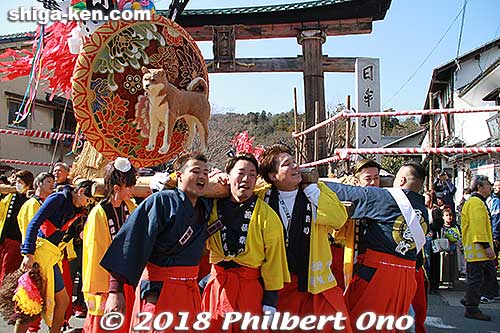 Sagicho Festival. More Omi-Hachiman photos here. Sagicho Festival. More Omi-Hachiman photos here.
| ||
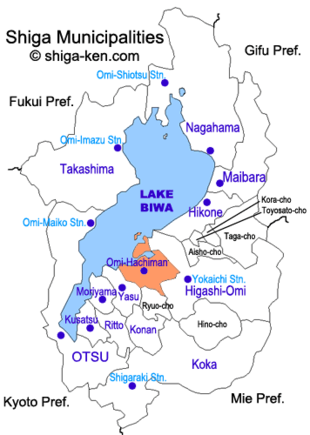
| ||
| Location | Shiga Prefecture, Kinki region, Honshu island, JAPAN | |
| Population | 82,355 (1,204 foreigners) (2014-06-01) | |
| Area | 177.39 km² | |
| City Centers | Hachiman-bori, Azuchi | |
| Major Sights | Hachiman-bori, Shin-machi, Hachiman-yama, Azuchi Castle, Chomeiji, Vories buildings, Okinoshima | |
| Major Gateways | JR Tokaido Main Line Omi-Hachiman Station | |
| Train Stations | JR Tokaido Main Line Omi-Hachiman Station, Azuchi Station, Shinohara Station; Ohmi Railways Omi-Hachiman Station, Musa Station | |
| Claim to Fame | Many buildings designed by William Vories, Azuchi Castle site | |
| Products | enter | |
| Neighbors | Higashiomi, Yasu, Ryuo-cho | |
| Old Name(s) | enter | |
| Keywords | Hachiman-bori canal, Omi shonin merchants, Vories, Azuchi, Nobunaga | |
| Historical Persons | Toyotomi Hidetsugu | |
| Links | Omi-Hachiman Articles | Omi-Hachiman Photos | |
| Omi-Hachiman Tourist Information | ||
| Location | 〒523-0864 滋賀県近江八幡市為心町元9 (白雲館内)
Omi-Hachiman Station, North exit | |
| Phone | Station: (0748) 33-6061, Hakuunkan:(0748)32-6181 | |
| Tourist Links | Tourism Ass. | |
| Int'l Association | Web site Phone: 0748-26-7092 | |
| Volunteer Guides | Website Azuchi guides Phone: 0748-33-6061 | |
| Omi-Hachiman City Hall 近江八幡市役所 | ||
| Address | 〒523-8501 近江八幡市桜宮町236
Sakuramiya-cho 236, Omi-Hachiman-shi, Shiga 523-8501 JAPAN | |
| Phone/Fax | 0748-33-3111 | |
| Official Site | Japanese | | |
| Symbols | Flower: | Scarlet sage サルビア |
| Tree: | Azalea and cherry blossom | |
| Bird: | None | |
| Others: | Suigo boats | |
| Logo: | 
| |
| Sister Cities | Grand Rapids, Michigan; Leavenworth, Kansas; Miryang, Kyongnam, South Korea; Fujinomiya, Shizuoka; Matsumae-cho, Hokkaido | |
by Philbert Ono, Updated: Nov. 11, 2022
Japanese- and Western-style Traditional Townscapes
Omi-Hachiman (近江八幡市; also spelled Omihachiman) is a small lakeside city on the east shore of Lake Biwa in Shiga Prefecture, Japan.
Famous for:
- Azuchi Castle built by Oda Nobunaga, but destroyed by fire.
- Traditional townscapes around Hachiman-bori Canal.
- Western architecture by William Merrell Vories.
- Sagicho Matsuri fire festival.
- Suigo waterways (boat rides).
- Cultivation of Omi beef.
- Headquarters of confectioner Taneya and Club Harie (La Collina).
A former castle town and merchant town with many remnants of its historical past, Omi-Hachiman is noted for traditional townscapes and many buildings designed by William Merrell Vories (1880-1964) who moved here from Kansas, USA. Great for architectural buffs. The city boasts two notable castle sites, Azuchi Castle built by warlord Oda Nobunaga and Hachiman Castle built by Toyotomi Hidetsugu. Although both castles structure have not survived, their foundations and stone walls still remain.
Omi-Hachiman also has a lot of waterscapes with canals, Lake Biwa, and Lake Nishinoko attached to Lake Biwa. Hachiman-bori canal at the foot of Mt. Hachiman-yama is the city's main tourist center with traditional townscapes, a large shrine (Himure Hachimangu Shrine), and summit of Mt. Hachiman-yama. Lake Nishinoko has Suigo boat rides that going through waterways and tall reeds. Suigo waterways in Omi-Hachiman were Japan's first "Important Cultural Scenery" (重要文化的景観). There are also cycling paths along the lakes.
Omi-Hachiman is also the headquarters of confection maker Taneya (founded in 1872) and subsidiary Club Harie famous for Baumkuchen. Their head store is in a park-like complex named La Collina, about 10 min. by bus from Omi-Hachiman Station. La Collina is one of Shiga's most popular attractions.
The Sagicho Matsuri festival held in mid-March is one of Shiga's major festivals climaxing in the burning of floats. At least two other festivals also feature fire: The Hachiman Matsuri in April featuring giant torches set afire, and Shinoda Hanabi Fireworks in May.
Locals just call the city "Hachiman" for short. On March 21, 2010, the city merged with the neighboring town of Azuchi which was reluctant to merge and lose its municipal and historic name.
Basic Orientation
The city's main train station is Omi-Hachiman Station on the JR Tokaido/Biwako Line. The station has the North and South Exits/Entrances. There are bus stops on both sides of the station. The North Exit has the tourist information office, rental bicycles, and bus stops to major sights such as Hachiman-bori, La Collina, and Chomeiji. The South Exit has buses going to the interior towns (away from the lake) such as Ryuo and Hino.
There are no tourist attractions near Omi-Hachiman Station, only a shopping mall, electronics shop, convenience stores, and restaurants. Go to the North Exit's tourist information office to find out which bus to take to your desired destination. Buses to Hachiman-bori or La Collina leave once or twice an hour.
If you want to see Azuchi Castle, go to Azuchi Station. Not all trains stop at Azuchi Station. You must take the Kaku-eki (local) train that stops at all tran stations. The kaisoku express trains don't stop at Azuchi. At Omi-Hachiman Station, you have to transfer to a local train for Azuchi.
Sights

| 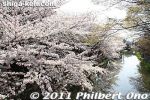
| 
|
| Shinmachi-dori | Hachiman-bori Canal | Sagicho Matsuri |

| 
| 
|
| Hachiman-yama | Chomeiji | Vories |
- La Collina Omi-Hachiman ラ コリーナ近江八幡 - Confection maker Taneya and Club Harie (both founded in Omi-Hachiman) have their main stores in this park-like, expansive rural space. Three buildings house cafes and confection shops amid a grassy and artsy space with a backdrop of mountains. You can buy their confections in the Main Shop with a grassy roof, have a coffee break with freshy baked Baumkuchen (while supplies last) or castella, stroll around the pleasant grounds with outdoor sculptures, and check out the funky gift shop with an old double-decker London bus. Very popular place. From Omi-Hachiman Station's North Exit, go to bus stop 6 and take the bus bound for Chomeiji or Kyukamura. Get off at Kitanosho La Collina-mae (北之庄 ラ コリーナ前). Parking also available.
- Shin-machi-dori - Traditional-looking street where you can enter magnificent Omi merchant homes like the former Nishikawa Residence and Ban family residence. The local history museum is also housed in the former residence of another Omi merchant, Nishimura Tarouemon. From Omi-Hachiman Station's North Exit, go to bus stop 6 and take the bus bound for Chomeiji or Kyukamura. Get off at Shin-machi bus stop and Hachiman-bori. Map
- Hachiman-bori 八幡堀 - As a part of Hachiman Castle, the Hachiman-bori moat enabled boats to reach the castle from Lake Biwa. It is famous for cherry blossoms in spring. A small but controversial foot bridge supported by wooden boats crosses the canal near the Kawara Roof Tile Museum. Hakuunkan, an eye-catching Western-style building, is also near the canal. Find a tourist info counter and souvenir shop inside. It was originally built as a school in 1877. Beautifully preserved. If you like Japanese confections, rest at Taneya confection shop. 8-min. bus ride from JR Omi-Hachiman Station’s north exit. Go to bus stop 6 and board the bus going to Chomeiji. You can get off at Shinmachi (新町) or Osugicho (大杉町). Map
- Himure Hachimangu Shrine 日牟禮八幡宮 - Omi-Hachiman's most prominent shrine is dedicated to a god of war. You can't miss it along Hachiman-bori moat. It holds the Sagicho Matsuri in March and Hachiman Matsuri torch festival in April. From Omi-Hachiman Station's North Exit, go to bus stop 6 and take the bus bound for Chomeiji or Kyukamura. Get off at Osugicho (大杉町). Map
- Mt. Hachiman-yama 八幡山 - At 271 meters high, this mountaintop was the site of Hachiman Castle built by Toyotomi Hidetsugu in 1585. Now home to Zuiryuji temple of the Nichiren Sect, some of the castle's stone walls still remain. Great views of Lake Biwa and Omi-Hachiman, as well as fall colors. Easily accessible via ropeway near Hachiman-bori canal. Short bus ride from JR Omi-Hachiman Station’s north exit. Go to bus stop 6 and board the bus going to Chomeiji. You can get off at Osugicho (大杉町). Map
- William Merrell Vories buildings - William Merrell Vories (1880-1964) is one of the most famous historical figures in Shiga. His legacy remains in physical form in many places through former bank buildings, post office branches, schools, and Christian churches. Vories moved from Kansas to Omi-Hachiman in 1905 to work as an English teacher while engaging in Christian missionary activities. He always had an interest in architecture and never had formal training as an architect, but he studied on his own and opened his own architectural firm in Omi-Hachiman in 1908. He and his firm went on to design numerous buildings in Shiga and other places in Japan. Omi-Hachiman still has a number of Vories buildings intact, including his former residence which you can visit. Other buildings can be admired from the outside only. Map
- Suigo Boat Ride 水郷めぐり - The Suigo boat ride in waterways connected to Lake Biwa and Lake Nishinoko is a major tourist attraction in Omi-Hachiman. Both hand-paddled boats and motorized boats provide rides, depending on which boat company you select. But the more traditional and quieter hand-paddled boats (like at Maruyama) are much more enjoyable we think. 8-min. bus ride from JR Omi-Hachiman Station’s north exit. Go to bus stop 6 and board the bus going to Chomeiji. Get off at Maruyama. Map
- Chomeiji 長命寺 - The 31st temple on the Saigoku (Western Japan) Pilgrimage circuit, Chomeiji (Long Life Temple) worships the Kannon goddess dedicated to long life and good health. If you don't have a car, you will have to climb a lot of stone steps. Accessible by bus from Omi-Hachiman Station and Hachiman-bori. 8-min. bus ride from JR Omi-Hachiman Station’s north exit. Go to bus stop 6 and board the bus going to Chomeiji. Map
- Okinoshima island 沖島 - Lake Biwa's largest island is inhabited by over 400 residents, mainly into fishing. It is a short boat ride away from Omi-Hachiman's Horikiri port. Map
Azuchi area

| 
| 
|
| Azuchi Castle | Azuchi Nobunaga Matsuri | Azuchi Castle Museum |
The following sights are near Azuchi Station. Note that not all trains stop at Azuchi Station. You must take the Kaku-eki (local) train that stops at all tran stations. The kaisoku express trains don't stop at Azuchi. At Omi-Hachiman Station, you can transfer to a local train for Azuchi Station.
- Azuchi Castle 安土城跡 - Built in 1579 by famous warlord Oda Nobunaga, Azuchi Castle was unique for its opulence and octagonal castle tower. Japan's Azuchi-Momoyama Period (1568–1600) is partially named after this castle. It was attacked and destroyed only 3 years later. The castle ruins are on a hill in Azuchi, Omi-Hachiman, Shiga Prefecture. Lots of stone work remains. Many stone steps to the top. A replica of the top portion of the castle tower is displayed at the House of Nobunaga museum near the castle ruins. Map
- Bungei no Sato 文芸の里 - A cultural facility and park area including House of Nobunaga and Shiga Prefectural Azuchi Castle Archaelogical Museum. Map
- House of Nobunaga 信長の館 (Nobunaga no Yakata) - A museum housing a magnificent replica of the top two floors of the Azuchi Castle's main tower. This replica was displayed in the Japan Pavilion at the Seville Expo '92 in Spain. Map
- Shiga Prefectural Azuchi Castle Archaelogical Museum 安土城考古博物館 (Azuchi-jo Koko Hakubutsukan) - Large facility preserving and showing the archaelogical remains of ancient times and from nearby Azuchi Castle. Map
- Azuchi Castle Museum 城郭資料館 (Azuchi Jokaku Shiryokan) - Castle museum next to Azuchi Station. The main exhibit is a 1/20 scale model (and cross section) of Azuchi Castle tower. Small admission charged. Open 9:00-17:00, closed Mon. and the day after a national holiday. Map
- Sasaki Shrine 沙沙貴神社 - Noted for numerous wintersweet (robai) blossoms with a very pleasant fragrance from late Jan. to early Feb. Short walk from Azuchi Station.
- Kannonji Castle ruins 観音寺城跡 - Atop Mt. Kinugasa 繖山 (also called Kannonji-yama) stood this medieval castle occupied by Sasaki Rokkaku. Many ruins and artifacts have been found. The elevation is 432 meters, a much higher climb than Azuchi Castle. Map
- Kyorinbo Garden 教林坊 - Japanese garden designed by Kobori Enshu. Part of Kannon Shoji temple at the foot of Mt. Kinugasa. Map
- Kannon Shoji temple 観音正寺 - Atop Mt. Kinugasa near the Kannonji Castle ruins, this is the 32nd temple of the Saigoku (Western Japan) Pilgrimage circuit of 33 temples. According to legend, Prince Shotoku received help from a mermaid to build this temple. Unfortunately the temple caught fire in 1993 and and the important Kannon wooden statue was destroyed. The temple was rebuilt in 2004, and a new Kannon statue was made.
Event Calendar
- Mid-March weekend - Sagicho Matsuri 左義長まつり - Held during the weekend in mid-March, the Sagicho Matsuri is a dramatic parade and clashing of 13 or 14 colorful Sagicho floats carried around the streets and in Himure Hachimangu Shrine near Hachiman-bori Canal. On the first day (Sat.), the floats are paraded along the streets near the shrine and undergo judging for best design. The floats are works of art and made of edible materials mounted on a straw and wood base. On the second day (Sun.), the Sagicho floats collide with each other and try to topple each other. At night, the floats are set afire. Sagicho is actually a fire festival. Map
- April 14-15 - Hachiman Matsuri 八幡まつり- Held annually at Himure Hachimangu Shrine, the Hachiman Matsuri is Shiga's biggest fire festival. Giant torches made of straw as tall as 10 meters are set on fire starting from 8 pm on the 14th. On the 15th, taiko drum processions appear. The festival is prayer for an abundant harvest. Map
- May 4 - Shinoda Shrine Hanabi fireworks 篠田の花火 - Very dramatic display of both aerial and ground fireworks as part of the shrine's religious ceremony. Torch fireworks, Niagara Falls, and panel-type fireworks provide an explosive experience. Good for people who cannot wait till summer to see fireworks in Japan. Walk from Omi-Hachiman Station. Intangible Folk Cultural Property. Map
- Mid-Nov. - Azuchi Nobunaga Festival honors Oda Nobunaga who built Azuchi Castle. Various events and activities highlighted by the Musha Gyoretsu warrior procession and a demonstration of firing matchlock guns. Warrior procession also passes by Azuchi Station. The boat ride along the moat is also enjoyable. Until 2019, the festival was held in early June, but now it's held in Nov. Official site Map
Travel Tips
- Omi-Hachiman Station has a tourist info office as well as inside Hakuunkan at Hachiman-bori. Many shops, restaurants, and movie theaters are also around the station.
- The Hachiman-bori area is the main tourist area where you can easily walk to Shinmachi-dori to see the Omi merchant homes, take the ropeway up Mt. Hachiman-yama, walk around the canal, and enter museums and buildings. From Omi-Hachiman Station, take the bus and get off at Shinmachi. See the merchant homes, then walk to the canal area.
- Everything in the Hachiman-bori area closes at around 5 pm or 6 pm. If you need to eat, best to go back to Omi-Hachiman Station.
- Current weather warnings/advisories for Omi-Hachiman here (Japan Meteorological Agency).
Getting There
Get on the JR Tokaido/Biwako Line and get off at Omi-Hachiman Station or Azuchi Station. Note that the kaisoku (or shin-kaisoku) express trains do not stop at Azuchi Station. You must take a local kaku-eki train.
From Tokyo, 2.5 hours to Maibara Station via Tokaido shinkansen bullet train, 20 min. from Maibara to Omi-Hachiman Station. From Kyoto, 31 min. to Omi-Hachiman Station via JR Tokaido/Biwako Line.
Getting Around
From Omi-Hachiman Station, local buses run to all the major places of interest. Buses also go to neighboring Ryuo-cho. Rental bicycles are also available at the station. Train stations within the city are as follows:
- Omi-Hachiman Station (近江八幡駅) - Visit Hachiman-bori moat which is the historical part of town, and buildings by the American architect Vories. Bicycle rental at the station.
- Azuchi Station (安土駅) - The kaisoku (or shin-kaisoku) express trains do not stop at Azuchi Station. You must take a local kaku-eki train to Azuchi Station. Bicycle rental available near the station.
- Shinohara Station (篠原駅) - Bicycle rental at recreational grounds Imose no Sato (雪野山史跡広場妹背の里) (0748-57-1819) until 5 pm.
Ohmi Railways Yokaichi Line (八日市線)
- Omi-Hachiman Station (近江八幡駅)
- Musa Station (武佐駅) - Former stage town on the Nakasendo Road. A few signs indicate where the Honjin and other buildings were, but none can be entered.
Maps
Click on upper right icon to enlarge.
Photos
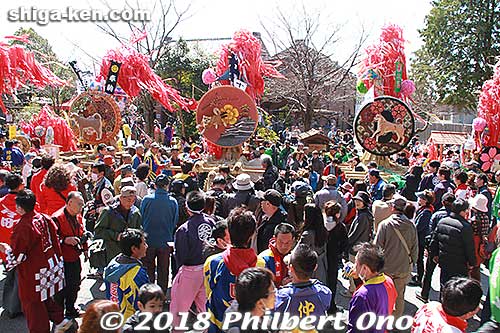
| 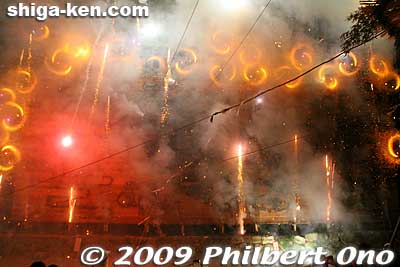
|
| Sagicho Festival | Shinoda Shrine fireworks |
More photos at Omi-Hachiman Photos. More Shiga photos here.
Videos
Click on the video image to start playing the video.
More Shiga videos here.
Side Trips
Other sights in neighboring cities/towns within easy reach from Omi-Hachiman.
- Azuchi-cho - Location of Azuchi Castle ruins. Only one train stop from Omi-Hachiman Station.
- Ryuo-cho - By bus from Omi-Hachiman Station.
- Higashi-Omi - Easy to reach via Ohmi Railways to Yokaichi.
History
- 1579 - Azuchi Castle is completed by Oda Nobunaga after three years of construction.
- 1582 - Azuchi Castle is attacked by the forces of Akechi Mitsuhide. The castle is burnt to the ground.
- 1914 - Azuchi Station opens for trains.
- 1954 - The towns of Oiso and Azuchi merge to form Azuchi-cho town.
- 1993 - A fire destroys Kannonsho-ji Temple's main hall and a Kannon statue.
- 2004 - Kannonsho-ji Temple's main hall is rebuilt and completed.
- 1954 Omi-Hachiman established as a city.
- 2006 A small, but beloved and essential wooden bridge supported by two wooden boats over Hachiman-bori canal faces controversy as an illegal structure.
- 2010 On March 21, Omi-Hachiman and Azuchi town merge. A mayoral election for the new city is held in the following month.
Additional Reading
Omi-Hachiman News - Curated tweets by ShigaHeadlines
FIFA World Cup soccer: Heartbreaking defeat for Japan after taking the lead over Belgium 2-0, but Belgium made a stunning comeback with 3 goals. Omi-Hachiman-native Takashi Inui even scored a goal, but it wasn't enough. Lots of tears, but stand tall Japan! https://t.co/heCJmgcHqF pic.twitter.com/iYUKmTQ9As
— Shiga Headlines (@ShigaHeadlines) July 2, 2018
In Omi-Hachiman today, visited one of the neighborhoods #宮内町 building a festival float for the Sagicho Matsuri on March 17–18. Made of edible materials featuring the Year of the Dog. Takes about 2 months to build. This dog's fur is made of jute fibers. Beautiful. #左義長まつり pic.twitter.com/h6KByNo4BH
— Shiga Headlines (@ShigaHeadlines) March 10, 2018
- Hachiman-bori, one of Shiga’s Top 5 cherry blossom spots - March 24, 2013
- Sagicho Matsuri festival schedule - March 4, 2012
- Shiga’s lip balm - September 30, 2011
- Historic ryokan in Musa destroyed by fire - December 10, 2010
- Omi-Hachiman and Azuchi merge - March 22, 2010
- William Merrell Vories exhibition - October 29, 2009
- Movie review: Katen no Shiro - September 16, 2009
- Omi-Hachiman to remain “Omi-Hachiman” after merging with Azuchi - May 24, 2009
- Rebuilding sacred secrets of ancient Omi Province (Kyorinbo) - The Japan Times, FEB 15, 2009
- The time before the ‘starchitects’ (William Vorie) - The Japan Times, FEB 28, 2008
- A prize catch for travel merchants - Omi merchants, The Japan Times, June 24, 2005
Miscellaneous
Trivia
- Many non-locals and tourists mispronounce Omi-Hachiman as "Omi-Yahata" or "Omi-Yawata" which are different ways of pronouncing the kanji characters.
- Local people in Shiga simply call it "Hachiman."
- The town of Azuchi since 1986 has been trying to find a folding screen with a painting of Azuchi Castle supposedly sent by Oda Nobunaga to Pope Gregorio XIII at the Vatican. In Nov. 2005, the town mayor was able to meet the Pope at the Vatican while showing what the folding screen might look like. The folding screen is yet to be found. The magnificent Azuchi Castle existed for only three years before it was burned to the ground. Since few records remain of the castle, the folding screen would shed much light on what the castle looked like.
- Next to Azuchi Station on the south side there was a sumo ring. Nobunaga held a sumo match in the area and thus helped to develop sumo. The sumo ring was demolished when Azuchi Station was rebuilt anew. However, a small statue of sumo wrestlers was built as a substitute.
Famous People
- Toyotomi Hidetsugu 豊臣秀次(1568-1595)
- Warlord who built Hachiman Castle.
- Oda Nobunaga 織田 信長 (1534-1582)
- Native of Owari (now Aichi Prefecture), major warlord who sought to conquer and unify Japan. He needed to control Shiga since it was next to Kyoto and a major crossroad. He built a magnificent castle in Azuchi, and also torched many Buddhist temples such as Enryakuji in 1571 whose warring monks might have opposed him. The Azuchi-Momoyama Period of Japanese history is partially named after the castle in Azuchi. Assassinated in Kyoto by Akechi Mitsuhide.
- William Merrell Vories (1880-1964)
- Native of Kansas who came to Omi-Hachiman in 1905 to teach English and do missionary work. Later he opened his own architectural firm and designed numerous Western-style buildings in Shiga, including Toyosato Primary School. Married a Japanese and became a naturalized Japanese citizen. His hometown of Leavenworth, Kansas and Omi-Hachiman are sister cities.
Related Articles
- Shiga Prefecture
- Shiga Prefecture Sights
- History of Shiga Prefecture
- Shiga Prefecture Transportation
External Links
- [http ]
| Municipalities of Shiga Prefecture 滋賀県 | ||
| Cities & Towns: Aisho-cho | Higashi-Omi | Hikone | Hino-cho | Koka | Konan | Kora-cho | Kusatsu | Maibara | Moriyama | Nagahama | Omi-Hachiman | Otsu | Ritto | Ryuo-cho | Taga-cho | Takashima | Toyosato-cho | Yasu | ||
| 愛荘町 | 東近江市 | 彦根市 | 日野町 | 甲賀市 | 湖南市 | 甲良町 | 草津市 | 米原市 | 守山市 | 長浜市 | 近江八幡市 | 大津市 | 栗東市 | 竜王町 | 多賀町 | 高島市 | 豊郷町 | 野洲市 | ||
| Prefectures of Japan | ||
| Aichi | Akita | Aomori | Chiba | Ehime | Fukui | Fukuoka | Fukushima | Gifu | Gunma | Hiroshima | Hokkaido | Hyogo | Ibaraki | Ishikawa | Iwate | Kagawa | Kagoshima | Kanagawa | Kochi | Kumamoto | Kyoto | Mie | Miyagi | Miyazaki | Nagano | Nagasaki | Nara | Niigata | Oita | Okayama | Okinawa | Osaka | Saga | Saitama | Shiga | Shimane | Shizuoka | Tochigi | Tokushima | Tokyo | Tottori | Toyama | Wakayama | Yamagata | Yamaguchi | Yamanashi | ||